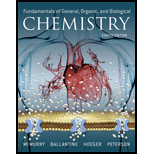
Pearson eText Fundamentals of General, Organic, and Biological Chemistry -- Instant Access (Pearson+)
8th Edition
ISBN: 9780135213759
Author: John McMurry, David Ballantine
Publisher: PEARSON+
expand_more
expand_more
format_list_bulleted
Concept explainers
Question
Chapter 28, Problem 28.34AP
Interpretation Introduction
Interpretation:
The general terms how the peptide hormone works has to be described.
Concept Introduction:
Hormones: Hormones are chemical messengers which are secreted by the cell in endocrine system and are transported along the blood to stimulate the target cells having the corresponding receptors.
Polypeptide hormones: Polypeptides are organic
Insulin is an example for a polypeptide hormone.
Expert Solution & Answer
Want to see the full answer?
Check out a sample textbook solution
Students have asked these similar questions
Describe a mechanism by which a steroid hormone might act to
increase intracellular levels of cyclic AMP.
Describe the chemical nature of prostaglandins. List some of the different forms of prostaglandins and describe their actions.
describe several physiological roles of prostaglandins.
Chapter 28 Solutions
Pearson eText Fundamentals of General, Organic, and Biological Chemistry -- Instant Access (Pearson+)
Ch. 28.1 - While thinking about how a messenger molecule and...Ch. 28.2 - Prob. 28.2PCh. 28.2 - Prob. 28.3PCh. 28.2 - Prob. 28.4PCh. 28.3 - Prob. 28.5PCh. 28.3 - Prob. 28.6KCPCh. 28.4 - Prob. 28.7PCh. 28.4 - Look at the structure of thyroxine shown earlier...Ch. 28.4 - Prob. 28.1CIAPCh. 28.4 - Prob. 28.2CIAP
Ch. 28.4 - Prob. 28.9PCh. 28.5 - Prob. 25.10PCh. 28.6 - Prob. 28.11PCh. 28.6 - Prob. 28.12PCh. 28.6 - Prob. 28.13KCPCh. 28.7 - Identify the functional groups present in THC. Is...Ch. 28.7 - Prob. 28.15KCPCh. 28 - Prob. 28.16UKCCh. 28 - Prob. 28.17UKCCh. 28 - Prob. 28.18UKCCh. 28 - Prob. 28.19UKCCh. 28 - Prob. 28.20UKCCh. 28 - Prob. 28.21UKCCh. 28 - Prob. 28.22APCh. 28 - Prob. 28.23APCh. 28 - Prob. 28.24APCh. 28 - Prob. 28.25APCh. 28 - Prob. 28.26APCh. 28 - Prob. 28.27APCh. 28 - Prob. 28.28APCh. 28 - Prob. 28.29APCh. 28 - Prob. 28.30APCh. 28 - Prob. 28.31APCh. 28 - Prob. 28.32APCh. 28 - Prob. 28.34APCh. 28 - Prob. 28.35APCh. 28 - Prob. 28.36APCh. 28 - Prob. 28.37APCh. 28 - How does epinephrine reach its target tissues?Ch. 28 - Prob. 28.39APCh. 28 - Prob. 28.40APCh. 28 - Prob. 28.41APCh. 28 - Prob. 28.42APCh. 28 - What enzyme catalyzes hydrolysis of the second...Ch. 28 - Prob. 28.44APCh. 28 - Prob. 28.45APCh. 28 - Prob. 28.46APCh. 28 - Prob. 28.47APCh. 28 - Prob. 28.48APCh. 28 - Prob. 28.49APCh. 28 - Prob. 28.50APCh. 28 - Prob. 28.51APCh. 28 - Prob. 28.52APCh. 28 - Prob. 28.53APCh. 28 - Prob. 28.54APCh. 28 - Prob. 28.55APCh. 28 - Prob. 28.56APCh. 28 - Prob. 28.57APCh. 28 - Prob. 28.58APCh. 28 - Prob. 28.59APCh. 28 - Prob. 28.60APCh. 28 - Prob. 28.62APCh. 28 - Prob. 28.63APCh. 28 - Prob. 28.64APCh. 28 - Prob. 28.65APCh. 28 - Prob. 28.66APCh. 28 - Prob. 28.67APCh. 28 - Prob. 28.68APCh. 28 - Prob. 28.69APCh. 28 - Prob. 28.70APCh. 28 - Prob. 28.71APCh. 28 - Prob. 28.72APCh. 28 - Prob. 28.73APCh. 28 - Prob. 28.74APCh. 28 - Prob. 28.75APCh. 28 - Prob. 28.76APCh. 28 - Why do we have brain receptors that respond to...Ch. 28 - Prob. 28.78APCh. 28 - Prob. 28.79APCh. 28 - Prob. 28.80APCh. 28 - Prob. 28.81APCh. 28 - Prob. 28.82APCh. 28 - Prob. 28.83CPCh. 28 - Prob. 28.84CPCh. 28 - Prob. 28.85CPCh. 28 - Prob. 28.86CPCh. 28 - Prob. 28.87CPCh. 28 - Prob. 28.88CPCh. 28 - Prob. 28.89CPCh. 28 - Prob. 28.90CPCh. 28 - Prob. 28.91CPCh. 28 - Prob. 28.92CPCh. 28 - Prob. 28.93CPCh. 28 - Prob. 28.94GPCh. 28 - Prob. 28.95GP
Knowledge Booster
Learn more about
Need a deep-dive on the concept behind this application? Look no further. Learn more about this topic, biochemistry and related others by exploring similar questions and additional content below.Similar questions
- What is the structural difference between an enzyme and a hormone?arrow_forwardWhat structural distinction exists between an enzyme and a hormone?arrow_forwardList the similarities and differences between prothoracicotropic hormone (PTTH) and ecdysone. Consider the structural and functional characteristics of both molecules.arrow_forward
- Describe the cellular mechanism of action of peptide hormonesarrow_forwardWhat peptides are expected to be produced when an unknown hormone (Asp−Glu−Ser−Met−Gln−Tyr−Asn−Arg−Glu−Ser−Lys−Pro−Leu ) is cleaved by: trypsin, cyanogen bromide, and thermolysin?arrow_forwardIdentify the shortest peptide hormone and explain its function.arrow_forward
arrow_back_ios
SEE MORE QUESTIONS
arrow_forward_ios
Recommended textbooks for you
 Human Physiology: From Cells to Systems (MindTap ...BiologyISBN:9781285866932Author:Lauralee SherwoodPublisher:Cengage Learning
Human Physiology: From Cells to Systems (MindTap ...BiologyISBN:9781285866932Author:Lauralee SherwoodPublisher:Cengage Learning

Human Physiology: From Cells to Systems (MindTap ...
Biology
ISBN:9781285866932
Author:Lauralee Sherwood
Publisher:Cengage Learning